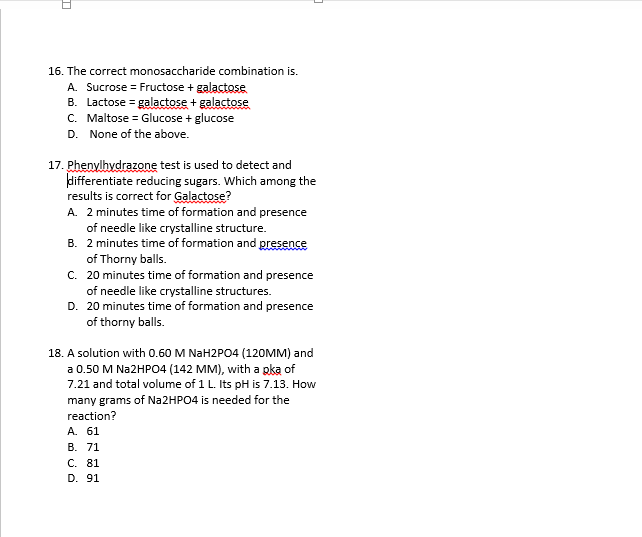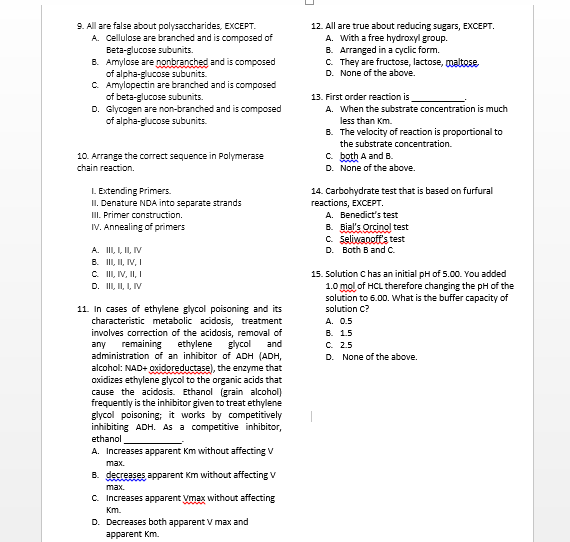16. The correct monosaccharide combination is. A. Sucrose = Fructose + galactose B. Lactose = galactose + galactose C. Maltose = Glucose + glucose D. None of the above. 17. Phenylhydrazone test is used to detect and differentiate reducing sugars. Which among the results is correct for Galactose? A. 2 minutes time of formation and presence of needle like crystalline structure. B. 2 minutes time of formation and presence of Thorny balls. C. 20 minutes time of formation and presence of needle like crystalline structures. D. 20 minutes time of formation and presence of thorny balls. 18. A solution with 0.60 M NaH2PO4 (120MM) and a 0.50 M Na2HPO4 (142 ММ), with a pka of 7.21 and total volume of 1 L. Its pH is 7.13. How many grams of N22HPO4 is needed for the reaction? A. 61 В. 71 С. 81 D. 91 9. All are false about polysaccharides, EXCEPT. A. Cellulose are branched and is composed of Beta-glucose subunits. B. Amylose are nonbranched and is composed of alpha-glucose subunits. C. Amylopectin are branched and is composed of beta-glucose subunits. D. Glycogen are non-branched and is composed of alpha-glucose subunits. 12. All are true about reducing sugars, EXCEPT. A. With a free hydroxyl group. B. Arranged in a cyclic form. C. They are fructose, lactose, maltose D. None of the above. 13. First order reaction is A. When the substrate concentration is much less than Km. B. The velocity of reaction the substrate concentration. s proportional to C. both A and B. D. None of the above. 10. Arrange the correct sequence in Polymerase chain reaction. I. Extending Primers. II. Denature NDA into separate strands III. Primer construction. IV. Annealing of primers 14. Carbohydrate test that is based on furfural reactions, EXCEPT. A. Benedict's test B. Bial's Orcinol test C. Selivanoff's test D. Both B and C. A. II, I, IL, IV B. II, II, IV, I C. II, IV, II, I D. II, II, I, IV 15. Solution C has an initial pH of 5.00. You added 1.0 mol of HCL therefore changing the pH of the solution to 6.00. what is the buffer capacity of solution C? A. 0.5 11. In cases of ethylene glycol poisoning and its characteristic metabolic acidosis, treatment involves correction of the acidosis, removal of В. 1.5 C. 2.5 D. None of the above. any remaining ethylene glycol and administration of an inhibitor of ADH (ADH, alcohol: NAD+ gxidoreductase), the enzyme that oxidizes ethylene glycol to the organic acids that cause the acidosis. Ethanol (grain alcohol) frequently is the inhibitor given to treat ethylene glycol poisoning; it works by competitively inhibiting ADH. As a competitive inhibitor, ethanol A. Increases apparent Km without affecting V max. B. decreases apparent Km without affecting v max. C. Increases apparent Vmax without affecting Km. D. Decreases both apparent V max and apparent Km.
16. The correct monosaccharide combination is. A. Sucrose = Fructose + galactose B. Lactose = galactose + galactose C. Maltose = Glucose + glucose D. None of the above. 17. Phenylhydrazone test is used to detect and differentiate reducing sugars. Which among the results is correct for Galactose? A. 2 minutes time of formation and presence of needle like crystalline structure. B. 2 minutes time of formation and presence of Thorny balls. C. 20 minutes time of formation and presence of needle like crystalline structures. D. 20 minutes time of formation and presence of thorny balls. 18. A solution with 0.60 M NaH2PO4 (120MM) and a 0.50 M Na2HPO4 (142 ММ), with a pka of 7.21 and total volume of 1 L. Its pH is 7.13. How many grams of N22HPO4 is needed for the reaction? A. 61 В. 71 С. 81 D. 91 9. All are false about polysaccharides, EXCEPT. A. Cellulose are branched and is composed of Beta-glucose subunits. B. Amylose are nonbranched and is composed of alpha-glucose subunits. C. Amylopectin are branched and is composed of beta-glucose subunits. D. Glycogen are non-branched and is composed of alpha-glucose subunits. 12. All are true about reducing sugars, EXCEPT. A. With a free hydroxyl group. B. Arranged in a cyclic form. C. They are fructose, lactose, maltose D. None of the above. 13. First order reaction is A. When the substrate concentration is much less than Km. B. The velocity of reaction the substrate concentration. s proportional to C. both A and B. D. None of the above. 10. Arrange the correct sequence in Polymerase chain reaction. I. Extending Primers. II. Denature NDA into separate strands III. Primer construction. IV. Annealing of primers 14. Carbohydrate test that is based on furfural reactions, EXCEPT. A. Benedict's test B. Bial's Orcinol test C. Selivanoff's test D. Both B and C. A. II, I, IL, IV B. II, II, IV, I C. II, IV, II, I D. II, II, I, IV 15. Solution C has an initial pH of 5.00. You added 1.0 mol of HCL therefore changing the pH of the solution to 6.00. what is the buffer capacity of solution C? A. 0.5 11. In cases of ethylene glycol poisoning and its characteristic metabolic acidosis, treatment involves correction of the acidosis, removal of В. 1.5 C. 2.5 D. None of the above. any remaining ethylene glycol and administration of an inhibitor of ADH (ADH, alcohol: NAD+ gxidoreductase), the enzyme that oxidizes ethylene glycol to the organic acids that cause the acidosis. Ethanol (grain alcohol) frequently is the inhibitor given to treat ethylene glycol poisoning; it works by competitively inhibiting ADH. As a competitive inhibitor, ethanol A. Increases apparent Km without affecting V max. B. decreases apparent Km without affecting v max. C. Increases apparent Vmax without affecting Km. D. Decreases both apparent V max and apparent Km.
Biology: The Dynamic Science (MindTap Course List)
4th Edition
ISBN:9781305389892
Author:Peter J. Russell, Paul E. Hertz, Beverly McMillan
Publisher:Peter J. Russell, Paul E. Hertz, Beverly McMillan
Chapter3: Biological Molecules: The Carbon Compounds Of Life
Section: Chapter Questions
Problem 2TYK: Which of the following characteristics is not common to carbohydrates, lipids, and proteins? a. They...
Related questions
Question
pls answer

Transcribed Image Text:16. The correct monosaccharide combination is.
A. Sucrose = Fructose + galactose
B. Lactose = galactose + galactose
C. Maltose = Glucose + glucose
D. None of the above.
17. Phenylhydrazone test is used to detect and
differentiate reducing sugars. Which among the
results is correct for Galactose?
A. 2 minutes time of formation and presence
of needle like crystalline structure.
B. 2 minutes time of formation and presence
of Thorny balls.
C. 20 minutes time of formation and presence
of needle like crystalline structures.
D. 20 minutes time of formation and presence
of thorny balls.
18. A solution with 0.60 M NaH2PO4 (120MM) and
a 0.50 M Na2HPO4 (142 ММ), with a pka of
7.21 and total volume of 1 L. Its pH is 7.13. How
many grams of N22HPO4 is needed for the
reaction?
A. 61
В. 71
С. 81
D. 91

Transcribed Image Text:9. All are false about polysaccharides, EXCEPT.
A. Cellulose are branched and is composed of
Beta-glucose subunits.
B. Amylose are nonbranched and is composed
of alpha-glucose subunits.
C. Amylopectin are branched and is composed
of beta-glucose subunits.
D. Glycogen are non-branched and is composed
of alpha-glucose subunits.
12. All are true about reducing sugars, EXCEPT.
A. With a free hydroxyl group.
B. Arranged in a cyclic form.
C. They are fructose, lactose, maltose
D. None of the above.
13. First order reaction is
A. When the substrate concentration is much
less than Km.
B. The velocity of reaction
the substrate concentration.
s proportional to
C. both A and B.
D. None of the above.
10. Arrange the correct sequence in Polymerase
chain reaction.
I. Extending Primers.
II. Denature NDA into separate strands
III. Primer construction.
IV. Annealing of primers
14. Carbohydrate test that is based on furfural
reactions, EXCEPT.
A. Benedict's test
B. Bial's Orcinol test
C. Selivanoff's test
D. Both B and C.
A. II, I, IL, IV
B. II, II, IV, I
C. II, IV, II, I
D. II, II, I, IV
15. Solution C has an initial pH of 5.00. You added
1.0 mol of HCL therefore changing the pH of the
solution to 6.00. what is the buffer capacity of
solution C?
A. 0.5
11. In cases of ethylene glycol poisoning and its
characteristic metabolic acidosis, treatment
involves correction of the acidosis, removal of
В. 1.5
C. 2.5
D. None of the above.
any
remaining
ethylene
glycol
and
administration of an inhibitor of ADH (ADH,
alcohol: NAD+ gxidoreductase), the enzyme that
oxidizes ethylene glycol to the organic acids that
cause the acidosis. Ethanol (grain alcohol)
frequently is the inhibitor given to treat ethylene
glycol poisoning; it works by competitively
inhibiting ADH. As a competitive inhibitor,
ethanol
A. Increases apparent Km without affecting V
max.
B. decreases apparent Km without affecting v
max.
C. Increases apparent Vmax without affecting
Km.
D. Decreases both apparent V max and
apparent Km.
Expert Solution
This question has been solved!
Explore an expertly crafted, step-by-step solution for a thorough understanding of key concepts.
Step by step
Solved in 2 steps with 2 images

Recommended textbooks for you

Biology: The Dynamic Science (MindTap Course List)
Biology
ISBN:
9781305389892
Author:
Peter J. Russell, Paul E. Hertz, Beverly McMillan
Publisher:
Cengage Learning

Biology: The Unity and Diversity of Life (MindTap…
Biology
ISBN:
9781305073951
Author:
Cecie Starr, Ralph Taggart, Christine Evers, Lisa Starr
Publisher:
Cengage Learning

Biology 2e
Biology
ISBN:
9781947172517
Author:
Matthew Douglas, Jung Choi, Mary Ann Clark
Publisher:
OpenStax

Biology: The Dynamic Science (MindTap Course List)
Biology
ISBN:
9781305389892
Author:
Peter J. Russell, Paul E. Hertz, Beverly McMillan
Publisher:
Cengage Learning

Biology: The Unity and Diversity of Life (MindTap…
Biology
ISBN:
9781305073951
Author:
Cecie Starr, Ralph Taggart, Christine Evers, Lisa Starr
Publisher:
Cengage Learning

Biology 2e
Biology
ISBN:
9781947172517
Author:
Matthew Douglas, Jung Choi, Mary Ann Clark
Publisher:
OpenStax

Biology: The Unity and Diversity of Life (MindTap…
Biology
ISBN:
9781337408332
Author:
Cecie Starr, Ralph Taggart, Christine Evers, Lisa Starr
Publisher:
Cengage Learning